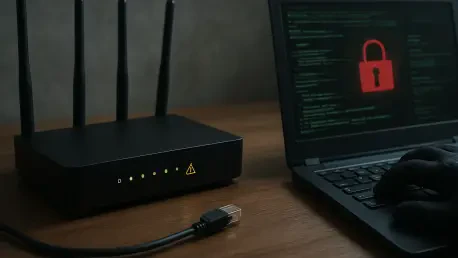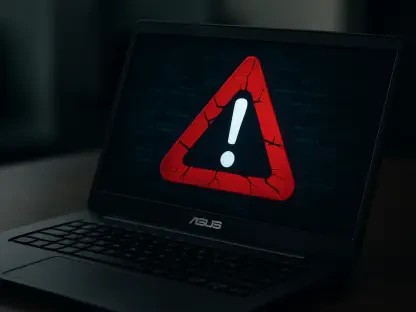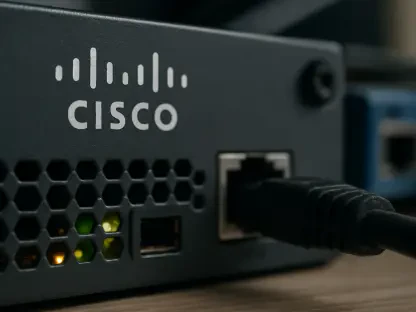What happens when the gateway to your digital world becomes a backdoor for cybercriminals? Right now, tens of thousands of ASUS routers across the globe are being hijacked in a sophisticated operation dubbed Operation WrtHug, catching the attention of cybersecurity experts and exposing a terrifying vulnerability in outdated network devices. This campaign turns these devices into tools for potential espionage or data theft, serving as a stark reminder of how neglected hardware can compromise personal and even national security.
The significance of this threat cannot be overstated. With over 50,000 unique IP addresses linked to compromised devices spanning Taiwan, the U.S., Russia, Southeast Asia, and Europe, Operation WrtHug reveals the scale of a coordinated cyberattack. As hackers exploit known flaws in end-of-life (EoL) ASUS routers, the risk extends beyond individual households to the creation of massive botnets capable of disrupting entire networks. Understanding this operation is critical, as it highlights a growing trend of targeting network infrastructure and underscores an urgent need for better cybersecurity practices.
A Hidden War on Digital Gateways
The invasion begins silently, often without users noticing a thing. Hackers behind Operation WrtHug target ASUS routers, particularly older models no longer supported by firmware updates, exploiting them as entry points into broader systems. These devices, once trusted to secure home and small business networks, are now pawns in a global scheme that has been unfolding over recent months, impacting thousands of unsuspecting users.
Taiwan appears to be a focal point, with a significant concentration of affected devices, alongside notable numbers in the U.S. and Russia. The sheer geographic spread of this attack suggests a deliberate strategy to maximize reach and impact. Cybersecurity researchers have tracked the operation’s growth, noting how quickly it has scaled to control a vast network of compromised hardware, raising alarms about the potential consequences.
This isn’t merely about losing control of a router; it’s about the broader implications of such breaches. Once hijacked, these devices can be used to steal sensitive data, launch further attacks, or even serve as relays in state-sponsored espionage efforts. The stakes are high, and the silent nature of this cyber siege makes it all the more dangerous.
Why ASUS Routers Are Prime Targets
ASUS routers, especially those classified as EoL, represent low-hanging fruit for cybercriminals due to their lack of ongoing security patches. Many users continue to rely on these outdated models, unaware that manufacturers have ceased support, leaving known vulnerabilities unaddressed. Operation WrtHug capitalizes on this neglect, zeroing in on specific flaws that allow attackers to gain unauthorized access with alarming ease.
The numbers paint a grim picture: nearly 99% of the compromised routers run ASUS AiCloud, a remote storage service riddled with inherent weaknesses that hackers exploit as a primary entry point. Models such as GT-AC5300, RT-AC1200HP, and DSL-AC68U are among the most affected, illustrating how a wide range of hardware is at risk. This isn’t a niche problem but a widespread crisis affecting diverse regions and user bases.
Beyond individual impact, the strategic targeting of network infrastructure signals a shift in cybercrime tactics. Routers, often overlooked in security protocols, are now central to building botnets that can disrupt critical systems or harvest data on a massive scale. This trend demands attention, as it reveals how everyday devices can become weapons in the hands of determined threat actors.
Inside the Attack: How Hackers Gain Control
Delving into the mechanics of Operation WrtHug uncovers a blend of cunning and precision. Attackers exploit six documented vulnerabilities in ASUS WRT routers, identified as CVE-2023-41345 through CVE-2023-41348, CVE-2023-39780, CVE-2024-12912, and CVE-2025-2492. These flaws allow them to bypass authentication and execute commands, effectively seizing full control over targeted devices.
Their methods are relentless: hackers chain exploits to install SSH backdoors, ensuring their access persists through reboots or updates. A peculiar hallmark of this campaign is a self-signed TLS certificate, valid for 100 years since its creation in 2022, found on infected routers. This unusual detail points to a highly organized effort, possibly hinting at the involvement of a sophisticated group with long-term goals.
Tactical similarities with other botnets, such as AyySSHush, add another layer of intrigue. Shared exploits and overlapping IP addresses suggest potential connections to China-linked cyber operations, though definitive attribution remains elusive. This raises pressing questions about whether this is the work of a rogue entity or a state-affiliated actor leveraging shared tools for maximum impact.
Voices from the Frontline: Expert Warnings
Cybersecurity professionals are increasingly vocal about the dangers posed by router-based attacks like Operation WrtHug. The STRIKE team at SecurityScorecard, which named and tracked this campaign, emphasizes its staggering scope, with over 50,000 devices compromised in a short span. One researcher remarked, “This isn’t random chaos; it’s a calculated move to exploit unsupported hardware as a stepping stone for larger malicious networks.”
Patterns observed in this operation mirror those of China Nexus campaigns, known for their strategic depth and meticulous execution. While no direct link has been confirmed, the heavy focus on Taiwan and the use of exploits like CVE-2023-39780—also seen in AyySSHush—fuel speculation about possible state involvement. Experts warn that such trends are becoming more common, with outdated devices serving as easy targets for building expansive botnets.
The consensus is clear: ignoring router security is no longer an option. As threat actors refine their approaches, the gap between supported and unsupported hardware becomes a glaring vulnerability. This perspective drives home the urgency of addressing these risks before they spiral into even larger threats on a global scale.
Safeguarding Your Network: Steps to Take Now
Protecting an ASUS router from threats like Operation WrtHug doesn’t require advanced technical skills, but it does demand vigilance. Start by checking the ASUS support page for firmware updates; if a device is listed as EoL, replacing it with a supported model is a wise move. Keeping software current is a fundamental defense against known exploits.
Limiting exposure is equally crucial. Disable features like AiCloud if they aren’t essential, as these services often serve as entry points for attackers. Strengthen access controls by replacing default credentials with strong, unique passwords and turning off remote management unless absolutely necessary. These simple adjustments can significantly reduce risk.
Finally, stay proactive by monitoring network activity for unusual patterns that might indicate a breach. Tools like network monitoring apps can help spot suspicious traffic. For owners of vulnerable models such as RT-AC1300UHP or GT-AX11000, upgrading to newer hardware is a priority to avoid the pitfalls of unsupported devices. Taking these measures not only secures individual networks but also helps curb the pool of exploitable devices fueling global cyber campaigns.
Reflecting on a Cyber Battle
Looking back, Operation WrtHug exposed a critical flaw in the digital landscape, where outdated ASUS routers became unwitting tools in a sprawling cyberattack. The campaign’s reach, affecting tens of thousands of devices across multiple continents, underscored the devastating potential of neglecting network security. It served as a harsh lesson in the importance of maintaining up-to-date hardware and software.
Moving forward, the focus must shift to prevention through collective action. Users are encouraged to prioritize firmware updates, disable unnecessary features, and replace EoL devices to fortify their defenses. Governments and manufacturers also bear responsibility to enhance support for legacy hardware and raise awareness about such threats.
Ultimately, this episode highlighted a path toward resilience. By investing in robust cybersecurity practices and fostering collaboration between individuals, companies, and policymakers, the digital community can better prepare for future challenges. The battle against cyber sieges like this one demands ongoing vigilance and a commitment to closing the gaps that hackers so readily exploit.









